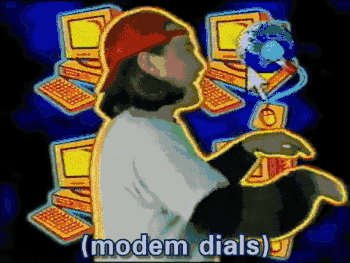- Dec 3, 2010
- 8,229
- 3,641
- 136
Question in the title. If everyone is now on broadband internet does that mean that dialup internet is better today than it was 10 years ago? Or no?
Wut?!Maybe it's the way you saying it but I don't get it.No, since with dialup, the limit is the last mile. You're never going to get more than dialup speeds because the tech that connects you to the CO is limited to that speed. Also, chances are the bandwidth is going through the same pipe as broadband anyway.
Now if the pipe going to the internet was congested back in the day, ex: you got much lower than 50kbps speeds, then it would be faster (ex: running at full dialup capabilities) since they've since upgraded the pipe and there's more bandwidth available.
Ia 56k the limits of dialup?
Yes, they would.Modern content heavy web pages on dial up would be horrific!
<Travis Bickle>You talkin' to me?</Travis Bickle>Is that satellite?
A friend of mine was using toast.net as of 2015, so I guess they're still around.
Oh, I missed you saying dsl in your op. That's some nasty ping you got there.<Travis Bickle>You talkin' to me?</Travis Bickle>
If so, that's my slowest DSL speedtest since mid January, when i started having speed issues.
Actually, under the best of condition you would likely only get around 53.3 Kilo bits per second. FCC defined operating voltages for equipment on the line talking to the telephone network was a big reason. But the other was simply no one had perfect line conditions between them and the receiving equipment. And it should be noted that a 56K modem using a standard telephone line took up a 64 kbps DS0 channel, which 24 DS0 channels make up a DS1, the Digital Signaling '1' class carrier. The difference between the 64K and the 56K is signaling and control.Ia 56k the limits of dialup?
Question in the title. If everyone is now on broadband internet does that mean that dialup internet is better today than it was 10 years ago? Or no?

Wut?!Maybe it's the way you saying it but I don't get it.
Dial up is slow because it is 100% analogue, it has to travel as sound and you can only switch from high to low that fast,broadband is 100% digital and you can switch between high and low much faster,DSL is even faster at switching because it uses light instead of electricity.
Switching = zeroes and ones = digital information.
LOL. Most un-informed post of the year, sadly.Dial up is slow because it is 100% analogue, it has to travel as sound and you can only switch from high to low that fast,broadband is 100% digital and you can switch between high and low much faster,DSL is even faster at switching because it uses light instead of electricity.
It ain't but not because of the customers. American telcos have wanted to get rid of the copper infrastructure in one swoop of a sale to some poor bastard too dumb to know it is a losing game. Much more profit off-facilities and large telcos know it. For instance, before BellSouth managed to get their sorry butts bought by SBC they actually tried to sell their POTS infrastructure and just lease access to it ... just like a CLEC would. And after SBC acquired BellSouth it tried to sell off its IFITL infrastructure and failed, but thankfully they finally got around in 2017? and converted the 1.8 Meg ports to full G ports. The original fiber was reused, but fiber from the lawn pedestals into the homes was needed, but that was cheap, as was the ONT.We still have copper everywhere here, but they introduced FTTH a while back to houses with aerial cable feed.
We still have DSLAMs from the early 2000's when they first introduced DSL, it's actually kinda funny seeing the evolution of the tech as you follow the rows of equipment in that room. only 8 customers per card at 1 meg each. Now with the Stingers there's 48 per card if I recall, and speeds up to 20ish megs but you only get that on a good day. When I was on DSL I got around 8, but in reality it was more like 5 actual.
I don't think our copper is going anywhere any time soon though as there's still tons of customers on the DMS and DSL alike.


